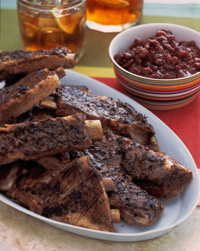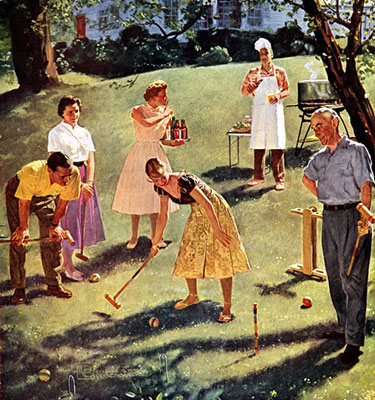 I grew up in the deep south, a small town called Hawkinsville, GA, population 3500. Probably the best thing I have ever eaten in my life is the BBQ we had on special occasions on our farm. I know, you can get BBQ everyday. Yes, I have been to those famous BBQ joints in Memphis and those in North Carolina. Not impressed; it's all about the sauce and good BBQ needs little sauce. My dad employed an old man named Clayton since I was a child until he died a few years ago. Great BBQ is an art, like the glass blowers in Murano, Italy or a small farmer in France making cheese. There is no recipe, just talent and experience.
I grew up in the deep south, a small town called Hawkinsville, GA, population 3500. Probably the best thing I have ever eaten in my life is the BBQ we had on special occasions on our farm. I know, you can get BBQ everyday. Yes, I have been to those famous BBQ joints in Memphis and those in North Carolina. Not impressed; it's all about the sauce and good BBQ needs little sauce. My dad employed an old man named Clayton since I was a child until he died a few years ago. Great BBQ is an art, like the glass blowers in Murano, Italy or a small farmer in France making cheese. There is no recipe, just talent and experience.
Food, Family and Memory
Food, Family, and Memory
When Neon was King
 My love affair with food began in the dim dark ages of the glorious 1990’s, when neon was king and it was cool to rock a mullet while listening to Marky Mark and his Funky Bunch. Born in San Diego and being brought up by a Hawaiian family from beautiful Kaneohe, greatly impacted my palate, and brought me to the culinary forefront well before my time.
My love affair with food began in the dim dark ages of the glorious 1990’s, when neon was king and it was cool to rock a mullet while listening to Marky Mark and his Funky Bunch. Born in San Diego and being brought up by a Hawaiian family from beautiful Kaneohe, greatly impacted my palate, and brought me to the culinary forefront well before my time.
The Hawaiian family unit is a large extended conglomeration made up of relatives and friends of the family, which basically makes dinnertime feel like riding ‘It’s a Small World’ at Disneyland, where everyone I’m not related to is either an ‘aunt,’ ‘uncle,’ or a ‘cousin.’ So in other words, it made finding a prom date that wasn’t a cousin, quite difficult. (That’s my excuse)
The Magic of the Season
 There is nothing special in the world. Nothing magic. Just physics." - Chuck Palahniuk, Diary
There is nothing special in the world. Nothing magic. Just physics." - Chuck Palahniuk, Diary
"Magic is just science we don't understand yet." - Sharon McCarragher
As I sent him out the door into the arctic darkness of a Michigan morning, I told my son that I was out of things to write about. "Give me something." I implored, "anything that pops into your head."
"Christmas lights" was his offering, as he left, bed-headed and sleep-eyed.
This was not the working of a fertile imagination; in order to leave the house he had to pass the lit Christmas tree, the lit garland in the foyer, and the unlit icicle lights on the front porch. It did, however, ignite the proverbial spark in me to write not only about Christmas lights, but about all of the magic that I still believe in, despite 47 years of exposure to the cynicism, disillusionment, pain and loss that exist in the world. I have seen the little man behind the curtain many, many times, but I still believe in the Great and Powerful Oz. Sue me.
As a child, I believed in all kinds of magic - Santa Claus, the Easter Bunny, the Tooth Fairy and the fountain in the mall into which one threw pennies and made wishes. My birthday was a kind of magical celebration of my wonderfulness, and the discovery of a woolly caterpillar on a tree trunk, a toad in the basement window well or a lady bug on a leaf was a unique and amazing event. I also believed that the animals could speak on Christmas Eve, and used to fall asleep on the floor next to our big Airedale, Katie, waiting for her to say something to me. Later, it gave me incalculable pleasure to recreate Santa et al for my own children, leaving elaborate trails of jelly beans through the house (before we had the dogs), making glitter-pen trails on letters from the Tooth Fairy, and simulating reindeer tracks in the snow.
Julie's Carrot Cake
 So, we had this awesome carrot cake down on Cumberland Island last November for our father’s birthday…the cake was baked and smuggled onto the island by Julie, Daddy’s wife and our new personal gourmet chef! This cake is unbelievably good and it is one of those dishes that lingers in your mind long after the last crumbs have been eaten. Obviously so, since I had the cake back in November and I was still reeling about it come February. I had to make the cake…I had to make the cake Julie’s way, so, I did. I followed her tweaks and tips for a successful cake and boy oh boy was it!
So, we had this awesome carrot cake down on Cumberland Island last November for our father’s birthday…the cake was baked and smuggled onto the island by Julie, Daddy’s wife and our new personal gourmet chef! This cake is unbelievably good and it is one of those dishes that lingers in your mind long after the last crumbs have been eaten. Obviously so, since I had the cake back in November and I was still reeling about it come February. I had to make the cake…I had to make the cake Julie’s way, so, I did. I followed her tweaks and tips for a successful cake and boy oh boy was it!
One of her tweaks on the traditional carrot cake recipe is to soak the carrots in cinnamon for three days…THREE DAYS!!! I thought this was crazy, but I wasn’t going to improve upon such a phenomenal dessert. Four cups of shredded, cinnamon soaked carrots, along with oil, flour, sugar, soda, eggs, additional cinnamon and salt constitute this cake. It is easy breezy to make, but takes some thoughtful culinary twists to enhance this dish to the next level.
Another tweak is the garnish…toasted and salted pecans. Now I could eat my weight in pecans, but toasting these and any nut for that matter brings out the flavor and enhances anything they complement. Butter and salt…good butter and sea salt mind you. No skimping there. The sweetness of the cake matched with the salty pecans is delectable.
Yet, the cake’s sweetness isn’t so much of a sugary sweet, but an earthy sweet brought on by the carrot and cinnamon love fest created three days prior! What else could this cake need…well, the perfect icing…a frosting of cream cheese lightly sweetened and buttery to perfection.
A Map of New Orleans
 Having vowed (in writing, which makes it serious) to have a more open, less fraught relationship with my mother, I am making time at least once a week to take her to lunch and have a good talk. By that I mean that I drive, and she pays for lunch. If my mother lets me pay for lunch, and we are not sharing a meal to celebrate my new job, bonus, lottery winnings or inheritance, it’s time to begin steering her gently towards a neuropsych evaluation.
Having vowed (in writing, which makes it serious) to have a more open, less fraught relationship with my mother, I am making time at least once a week to take her to lunch and have a good talk. By that I mean that I drive, and she pays for lunch. If my mother lets me pay for lunch, and we are not sharing a meal to celebrate my new job, bonus, lottery winnings or inheritance, it’s time to begin steering her gently towards a neuropsych evaluation.
So yesterday we ended up at a lovely little sushi place where I could eat sushi, and she could have something else. She had already asked me to take her to Talbot’s, for me the retail equivalent of the Bataan Death March, and I had agreed; the whole point of our time together was that I would not look at my watch, think about what else I could be doing, or patronize her with my opinions of her taste in preppy shifts and cardigans. She is my mother, and it is not only unkind but backwards to assume that age and illness have rendered her a child requiring my guidance. As I dabbed a little wasabi on my spicy tuna, she made a second request: since my brother and his wife were going to New Orleans soon, could we stop by the book store so that she could buy them a map?
Before I could stop myself, before I could re-direct my automatic inner know-it-all, I said “no one uses maps, mom. I mean, I’ll take you if you want to go, but they both have smart phones, and he has GPS on his phone, and I just can’t see them hauling out a map.” She put down her chopsticks, and narrowed her eyes.
More Articles ...
Welcome to the new One for the Table ...
Our Home Page will be different each time you arrive.
We're sure you'll find something to pique your interest...


